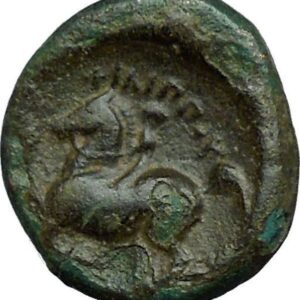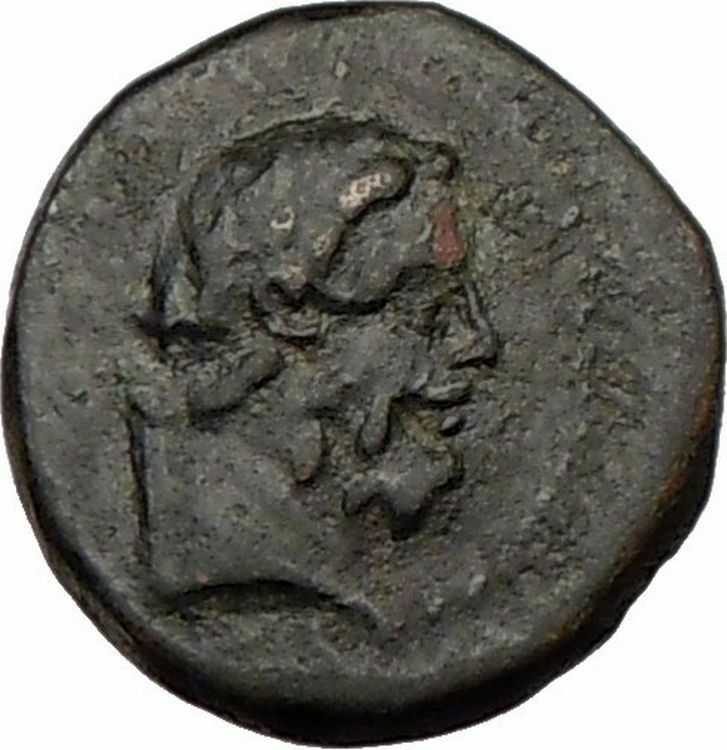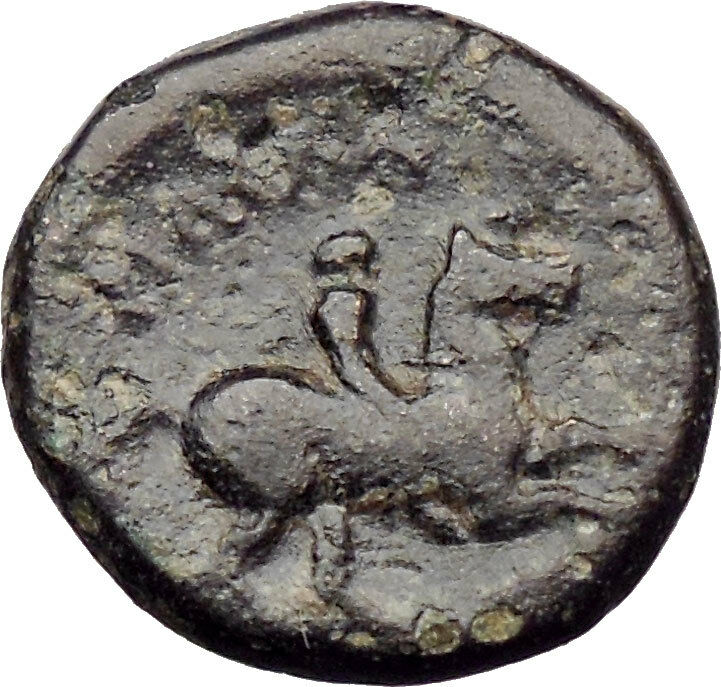To consolidate his empire and strengthen his hold over the region, Antiochus
Rebellion
|
| Power – Symbol |
Preterist view |
Historicist view |
|---|---|---|
| Great – Ram Daniel 8:4 |
Medo Persia | Medo Persia |
| Very Great – Goat Daniel 8:8 |
Greece | Greece |
| Exceeding Great – Little Horn Daniel 8:9-10 |
Antiochus IV (8th in line of 26 Seleucid Kings) | Rome |
It is important to note that the Little Horn power according to the
progression shown in Daniel 8 will have more influence and dominion than did the
Persian Empire which controlled from India to Ethiopia (Esther
1:1) and
Alexander the Great
who conquered the then
known world before the age of 32. The historical evidence shows that the
exploits of Antiochus Epiphanes is lacking in this regard.
The little horn was also to “stand up against the prince of princes”
Daniel 8:25
. That the prince of princes
represents
Jesus Christ
is of little dispute (Revelation
1:5,
Revelation 17:14
,
Revelation 19:16
). Antiochus IV died some 160
years before Jesus Christ was born. Rome, however was the dominant power that
held sway during the attempt to kill Christ as a child (Herod) and His
crucifixion (Acts
4:26-27).
That the little horn is “broken without hands” (Daniel
8:25) seems to be a reference to the events described in (Daniel
2:34) where a stone “cut out without hands” strikes the statue at the
feet representing the divided kingdoms of Rome.
Antiochus IV also paid tribute to Rome. The power that is described as
“exceeding great” would most likely be the power collecting a
tribute
rather than paying one.

Apollo Belvedere
,
ca. 120–140 CE
Apollo is one of the most important and
complex of the
Olympian deities
in
ancient Greek
and
Roman religion
,
Greek
and
Roman mythology
,
and
Greco
–Roman
Neopaganism
. The
ideal of the
kouros
(a
beardless, athletic youth), Apollo has been
variously recognized as a god of light and the sun,
truth and prophecy, healing, plague, music, poetry,
and more. Apollo is the son of
Zeus
and
Leto
, and has a
twin sister, the chaste huntress
Artemis
. Apollo is
known in Greek-influenced
Etruscan mythology
as Apulu.
As the patron of
Delphi
(Pythian
Apollo), Apollo was an
oracular
god—the
prophetic deity of the
Delphic Oracle
.
Medicine and healing are associated with Apollo,
whether through the god himself or mediated through
his son
Asclepius
, yet
Apollo was also seen as a god who could bring
ill-health and deadly
plague
. Amongst the
god’s custodial charges, Apollo became associated
with dominion over
colonists
, and as
the patron defender of herds and flocks. As the
leader of the
Muses
(Apollon
Musegetes) and director of their choir, Apollo
functioned as the patron god of music and poetry.
Hermes
created the
lyre
for him, and
the instrument became a common
attribute of Apollo
.
Hymns sung to Apollo were called
paeans
.
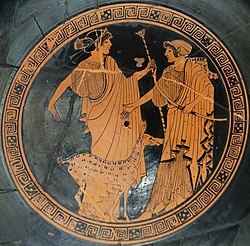
Apollo (left) and
Artemis
.
Brygos
(potter signed), Tondo of an Attic
red-figure cup c. 470 BC,
Musée du Louvre
.
In Hellenistic times, especially during the 3rd
century BCE, as Apollo Helios he became
identified among Greeks with
Helios
,
Titan
god of the sun
, and
his sister Artemis similarly equated with
Selene
, Titan
goddess of the moon
In Latin texts, on the other hand,
Joseph Fontenrose
declared himself unable to find any conflation of
Apollo with
Sol
among the
Augustan poets
of
the 1st century, not even in the conjurations of
Aeneas
and
Latinus
in
Aeneid
XII
(161–215). Apollo and Helios/Sol remained separate
beings in literary and mythological texts until the
3rd century CE.
Origins

Omphalos
in the Museum of
Delphi
.
The cult centers of Apollo in Greece,
Delphi
and
Delos
, date from
the 8th century BCE. The Delos sanctuary was
primarily dedicated to
Artemis
, Apollo’s
twin sister. At Delphi, Apollo was venerated as the
slayer of
Pytho
. For the
Greeks, Apollo was all the Gods in one and through
the centuries he acquired different functions which
could originate from different gods. In
archaic Greece
he
was the
prophet
, the
oracular god who in older times was connected with
“healing”. In
classical Greece
he
was the god of light and of music, but in popular
religion he had a strong function to keep away evil.
From his eastern-origin Apollo brought the art of
inspection from “symbols and
omina
” (σημεία και
τέρατα : semeia kai terata), and of the
observation of the
omens
of the days.
The inspiration oracular-cult was probably
introduced from
Anatolia
. The
ritualism
belonged
to Apollo from the beginning. The Greeks created the
legalism
, the
supervision of the orders of the gods, and the
demand for moderation and harmony. Apollo became the
god of shining youth, the protector of music,
spiritual-life, moderation and perceptible order.
The improvement of the old
Anatolian
god, and
his elevation to an intellectual sphere, may be
considered an achievement of the
Greek
people.
Healer and god-protector from evil
The function of Apollo as a “healer” is connected
with
Paean
, the
physician of the Gods in the
Iliad
, who
seems to come from a more primitive religion. Paeοn
is probably connected with the
Mycenean
Pa-ja-wo,
but the etymology is the only evidence. He did not
have a separate cult, but he was the personification
of the holy magic-song sung by the magicians that
was supposed to cure disease. Later the Greeks knew
the original meaning of the relevant song “paean”.
The magicians were also called “seer-doctors”, and
they used an ecstatic prophetic art which was used
exactly by the god Apollo at the oracles.
In the Iliad, Apollo is the healer under
the gods, but he is also the bringer of disease and
death with his arrows, similar to the function of
the terrible
Vedic
god of
disease
Rudra
.He sends a
terrible plague to the
Achaeans
. The god
who sends a disease can also prevent from it,
therefore when it stops they make a purifying
ceremony and offer him an “hecatomb” to ward off
evil. When the oath of his priest appeases, they
pray and with a song they call their own god, the
beautiful Paean.
Some common epithets of Apollo as a healer are
“paion” , “epikourios”, “oulios”, and “loimios” . In
classical times, his strong function in popular
religion was to keep away evil, and was therefore
called “apotropaios” and “alexikakos” , throw away
the evil).
In later writers, the word, usually
spelled “Paean”, becomes a mere epithet of Apollo in
his capacity as a god of
healing
.
Homer illustrated Paeon the god, and the song
both of
apotropaic
thanksgiving or triumph. Such songs were originally
addressed to Apollo, and afterwards to other gods:
to
Dionysus
, to Apollo
Helios
, to Apollo’s
son
Asclepius
the
healer. About the 4th century BCE, the paean became
merely a formula of adulation; its object was either
to implore protection against disease and
misfortune, or to offer thanks after such protection
had been rendered. It was in this way that Apollo
had become recognised as the god of music. Apollo’s
role as the slayer of the
Python
led to his
association with battle and victory; hence it became
the
Roman
custom for a
paean to be sung by an army on the march and before
entering into battle, when a fleet left the harbour,
and also after a victory had been won.
Oracular cult

Columns of the
Temple of Apollo
at Delphi, Greece.
Unusually among the Olympic deities, Apollo had
two cult sites that had widespread influence:
Delos
and
Delphi
. In cult
practice,
Delian Apollo
and
Pythian Apollo
(the
Apollo of Delphi) were so distinct that they might
both have shrines in the same locality.Apollo’s
cult
was already
fully established when written sources commenced,
about 650 BCE. Apollo became extremely important to
the Greek world as an oracular deity in the
archaic period
, and
the frequency of
theophoric names
such as Apollodorus or Apollonios and
cities named Apollonia testify to his
popularity. Oracular sanctuaries to Apollo were
established in other sites. In the 2nd and 3rd
century CE, those at
Didyma
and
Clarus
pronounced
the so-called “theological oracles”, in which Apollo
confirms that all deities are aspects or servants of
an
all-encompassing, highest
deity
. “In the 3rd century, Apollo fell
silent.
Julian the Apostate
(359 – 61) tried to revive the Delphic oracle, but
failed
The Seleucid Empire (/dɨˈluːsɪs/;
from
Greek
:
Σελεύκεια,
Seleúkeia)
was a
Hellenistic
state
ruled by the Seleucid dynasty founded by
Seleucus I Nicator
following the division of the empire created by
Alexander the Great
.
Seleucus received
Babylonia
and, from
there, expanded his dominions to include much of
Alexander’s
near eastern
territories. At the height of its power, it included
central
Anatolia
, the
Levant
,
Mesopotamia
,
Kuwait
,
Persia
,
Afghanistan
,
Turkmenistan
, and
northwest parts of
India
.

The Seleucid Empire was a major center of
Hellenistic
culture
that maintained the preeminence of
Greek
customs where
a Greek-Macedonian political elite dominated, mostly
in the urban areas. The Greek population of the
cities who formed the dominant elite were reinforced
by emigration from
Greece
. Seleucid
expansion into
Anatolia
and Greece
was abruptly halted after
decisive defeats
at
the hands of the
Roman army
. Their
attempts to defeat their old enemy
Ptolemaic Egypt
were frustrated by Roman demands. Much of the
eastern part of the empire was conquered by the
Parthians
under
Mithridates I of Parthia
in the mid-2nd century BC, yet the Seleucid kings
continued to rule a
rump state
from
Syria
until the
invasion by
Armenian
king
Tigranes the Great
and their ultimate overthrow by the
Roman
general
Pompey
.
History
Partition of Alexander’s empire
Alexander
conquered
the
Persian Empire
under its last Achaemenid dynast,
Darius III
, within
a short time frame and died young, leaving an
expansive empire of partly Hellenised culture
without an adult heir. The empire was put under the
authority of a regent in the person of
Perdiccas
in 323
BC, and the territories were divided between
Alexander’s generals, who thereby became
satraps
, at the
Partition of Babylon
in 323 BC.
Rise of Seleucus
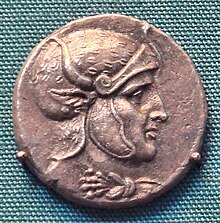
Seleucus I Nicator
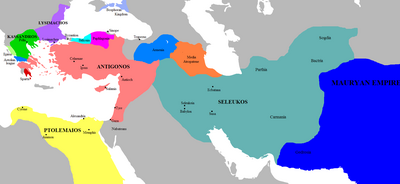
Diadochi
circa 303 BC
Alexander’s generals (the
Diadochi
) jostled
for supremacy over parts of his empire.
Ptolemy
, a former
general and the satrap of
Egypt
, was the
first to challenge the new system; this led to the
demise of Perdiccas. Ptolemy’s revolt led to a new
subdivision of the empire with the
Partition of Triparadisus
in 320 BC.
Seleucus
, who had
been “Commander-in-Chief of the camp” under
Perdiccas since 323 BC but helped to assassinate him
later, received
Babylonia
and, from
that point, continued to expand his dominions
ruthlessly. Seleucus established himself in
Babylon
in 312 BC,
the year used as the foundation date of the Seleucid
Empire. He ruled not only Babylonia, but the entire
enormous eastern part of Alexander’s empire:
“Always lying in wait for the neighboring
nations, strong in arms and persuasive in
council, he [Seleucus] acquired Mesopotamia,
Armenia, ‘Seleucid’ Cappadocia, Persis, Parthia,
Bactria, Arabia, Tapouria, Sogdia, Arachosia,
Hyrcania, and other adjacent peoples that had
been subdued by Alexander, as far as the river
Indus, so that the boundaries of his empire were
the most extensive in Asia after that of
Alexander. The whole region from Phrygia to the
Indus was subject to Seleucus.”—
Appian
, The
Syrian Wars
Seleucus
went as
far as
India
, where, after
two years of war
,
he reached an agreement with
Chandragupta Maurya
,
in which he exchanged his eastern territories for a
considerable force of 500
war elephants
,
which would play a decisive role at
Ipsus
(301 BC).
“The Indians occupy [in part] some of the
countries situated along the Indus, which
formerly belonged to the Persians: Alexander
deprived the Ariani of them, and established
there settlements of his own. But
Seleucus Nicatorgave them to
Sandrocottus
in
consequence of a marriage contract, and received
in return five hundred elephants.”—Strabo, Geographica
Westward expansion
Following his and
Lysimachus
‘ victory
over
Antigonus Monophthalmus
at the decisive
Battle of Ipsus
in
301 BC, Seleucus took control over eastern
Anatolia
and
northern
Syria
.
In the latter area, he founded a new capital at
Antioch on the Orontes
,
a city he named after his father. An alternative
capital was established at
Seleucia on the Tigris
,
north of Babylon. Seleucus’s empire reached its
greatest extent following his defeat of his
erstwhile ally, Lysimachus, at
Corupedion
in 281
BC, after which Seleucus expanded his control to
encompass western Anatolia. He hoped further to take
control of Lysimachus’s lands in Europe – primarily
Thrace
and even
Macedonia
itself,
but was assassinated by
Ptolemy Ceraunus
on
landing in Europe.
His son and successor,
Antiochus I Soter
,
was left with an enormous realm consisting of nearly
all of the Asian portions of the Empire, but faced
with
Antigonus II Gonatas
in Macedonia and
Ptolemy II Philadelphus
in
Egypt
, he proved
unable to pick up where his father had left off in
conquering the European portions of Alexander’s
empire.
An overextended domain
Nevertheless, even before Seleucus’ death, it was
difficult to assert control over the vast eastern
domains of the Seleucids. Seleucus invaded
Punjab region
region of
India
in 305 BC,
confronting
Chandragupta Maurya
(Sandrokottos),
founder of the
Maurya empire
. It
is said that Chandragupta fielded an army of 600,000
men and 9,000 war elephants (Pliny, Natural
History VI, 22.4).
Mainstream scholarship asserts that Chandragupta
received vast territory, sealed in a treaty, west of
the Indus, including the
Hindu Kush
, modern
day
Afghanistan
, and
the
Balochistan
province of
Pakistan
.
Archaeologically, concrete indications of Mauryan
rule, such as the inscriptions of the
Edicts of Ashoka
,
are known as far as
Kandahar
in
southern Afghanistan.
It is generally thought that Chandragupta married
Seleucus’s
daughter, or a
Macedonian
princess
, a gift
from Seleucus to formalize an alliance. In a return
gesture, Chandragupta sent 500
war
–elephants,
a military asset which would play a decisive role at
the
Battle of Ipsus
in
301 BC. In addition to this treaty, Seleucus
dispatched an ambassador,
Megasthenes
, to
Chandragupta, and later
Deimakos
to his son
Bindusara
, at the
Mauryan court at
Pataliputra
(modern
Patna
in
Bihar state
).
Megasthenes wrote detailed descriptions of India and
Chandragupta’s reign, which have been partly
preserved to us through
Diodorus Siculus
.
Later
Ptolemy II Philadelphus
,
the ruler of
Ptolemaic Egypt
and
contemporary of
Ashoka the Great
,
is also recorded by
Pliny the Elder
as
having sent an ambassador named
Dionysius
to the
Mauryan court.
Other territories lost before Seleucus’ death
were
Gedrosia
in the
south-east of the Iranian plateau, and, to the north
of this,
Arachosia
on the
west bank of the
Indus River
.
Antiochus I (reigned 281–261 BC) and his son and
successor
Antiochus II Theos
(reigned 261–246 BC) were faced with challenges in
the west, including repeated wars with
Ptolemy II
and a
Celtic
invasion of
Asia Minor — distracting attention from holding the
eastern portions of the Empire together. Towards the
end of Antiochus II’s reign, various provinces
simultaneously asserted their independence, such as
Bactria
under
Diodotus
,
Parthia
under
Arsaces
, and
Cappadocia
under
Ariarathes III
.

Bactria
,
the satrap
Diodotus
asserted independence to form the
Greco-Bactrian
kingdom
c.245 BC.
Diodotus
, governor
for the
Bactrian
territory,
asserted independence in around 245 BC, although the
exact date is far from certain, to form the
Greco-Bactrian
kingdom. This kingdom was characterized by a rich
Hellenistic
culture, and was to continue its domination of
Bactria until around 125 BC, when it was overrun by
the invasion of northern nomads. One of the
Greco-Bactrian kings,
Demetrius I of Bactria
,
invaded India around 180 BC to form the
Greco-Indian
kingdom, lasting until around AD 20.
The Seleucid satrap of Parthia, named
Andragoras
, first
claimed independence, in a parallel to the secession
of his Bactrian neighbour. Soon after however, a
Parthian tribal chief called
Arsaces
invaded the Parthian
territory around 238 BC to form the
Arsacid Dynasty
—
the starting point of the powerful
Parthian Empire
.
By the time Antiochus II’s son
Seleucus II Callinicus
came to the throne around 246 BC, the Seleucids
seemed to be at a low ebb indeed. Seleucus II was
soon dramatically defeated in the
Third Syrian War
against
Ptolemy III of Egypt
and then had to fight a civil war against his own
brother
Antiochus Hierax
.
Taking advantage of this distraction, Bactria and
Parthia seceded from the empire. In Asia Minor too,
the Seleucid dynasty seemed to be losing control —
Gauls had fully established themselves in
Galatia
,
semi-independent semi-Hellenized kingdoms had sprung
up in
Bithynia
,
Pontus
, and
Cappadocia
, and the
city of
Pergamum
in the
west was asserting its independence under the
Attalid Dynasty
.
Revival (223–191 BC)

Antiochus III the
Great
.
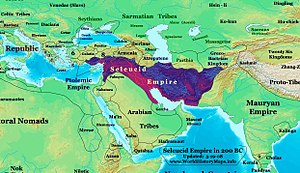
expansion into
Anatolia
and
Greece
).
A revival would begin when Seleucus II’s younger
son,
Antiochus III the Great
,
took the throne in 223 BC. Although initially
unsuccessful in the
Fourth Syrian War
against Egypt, which led to a defeat at the
Battle of Raphia
(217 BC), Antiochus would prove himself to be the
greatest of the Seleucid rulers after Seleucus I
himself. He spent the next ten years on his
anabasis
through
the eastern parts of his domain and restoring
rebellious vassals like Parthia and
Greco-Bactria
to at
least nominal obedience. He won the
Battle of the Arius
and
besieged the Bactrian capital
,
and even emulated Alexander with an expedition into
India where he met with king
Sophagasenus
receiving war elephants:
“He (Antiochus) crossed the Caucasus and
descended into India; renewed his friendship
with Sophagasenus the king of the Indians;
received more elephants, until he had a hundred
and fifty altogether; and having once more
provisioned his troops, set out again personally
with his army: leaving Androsthenes of Cyzicus
the duty of taking home the treasure which this
king had agreed to hand over to him”.
Polybius 11.39
When he returned to the west in 205 BC, Antiochus
found that with the death of
Ptolemy IV
, the
situation now looked propitious for another western
campaign. Antiochus and
Philip V of Macedon
then made a pact to divide the Ptolemaic possessions
outside of Egypt, and in the
Fifth Syrian War
,
the Seleucids ousted
Ptolemy V
from
control of
Coele-Syria
. The
Battle of Panium
(198 BC) definitively transferred these holdings
from the Ptolemies to the Seleucids. Antiochus
appeared, at the least, to have restored the
Seleucid Kingdom to glory.
Expansion into Greece and War with Rome
Following his erstwhile ally
Philip’s
defeat by
Rome in 197 BC, Antiochus saw the opportunity for
expansion into Greece itself. Encouraged by the
exiled
Carthaginian
general
Hannibal
, and
making an alliance with the disgruntled
Aetolian League
,
Antiochus launched an invasion across the
Hellespont
. With
his huge army he was intent upon establishing the
Seleucid empire as the foremost power in the
Hellenic world but these plans put the empire on a
collision course with the new superpower of the
Mediterranean, the
Roman Republic
. At
the battles of
Thermopylae
and
Magnesia
,
Antiochus’s forces were resoundingly defeated and he
was compelled to make peace and sign the
Treaty of Apamea
in
(188 BC), the main clause of which saw the Seleucids
agree to pay a large indemnity, retreat from
Anatolia
and to
never again attempt to expand Seleucid territory
west of the
Taurus Mountains
.
The
Kingdom of Pergamum
and the
Republic of Rhodes
,
Rome’s allies in the war, were given the former
Seleucid lands in Anatolia. Antiochus died in 187 BC
on another expedition to the east, where he sought
to extract money to pay the indemnity.
Roman power, Parthia and Judea
The reign of his son and successor
Seleucus IV Philopator
(187-175 BC) was largely spent in attempts to pay
the large indemnity, and Seleucus was ultimately
assassinated by his minister
Heliodorus
.
Seleucus’ younger brother,
Antiochus IV Epiphanes
,
now seized the throne. He attempted to restore
Seleucid power and prestige with a successful war
against the old enemy,
Ptolemaic Egypt
,
which met with initial success as the Seleucids
defeated and drove the Egyptian army back to
Alexandria
itself.
As the king planned on how to conclude the war, he
was informed that Roman commissioners, led by the
Proconsul
Gaius Popillius Laenas
,
were near and requesting a meeting with the Seleucid
king. Antiochus agreed, but when they met and
Antiochus held out his hand in friendship, Popilius
placed in his hand the tablets on which was written
the decree of the senate and telling him to read it.
When the king said that he would call his friends
into council and consider what he ought to do,
Popilius drew a circle in the sand around the king’s
feet with the stick he was carrying and said,
“Before you step out of that circle give me a reply
to lay before the senate.” For a few moments he
hesitated, astounded at such a peremptory order, and
at last replied, “I will do what the senate thinks
right.” He then chose to withdraw rather than set
the empire to war with Rome again.
The latter part of his reign saw a further
disintegration of the Empire despite his best
efforts. Weakened economically, militarily and by
loss of prestige, the Empire became vulnerable to
rebels in the eastern areas of the empire, who began
to further undermine the empire while the Parthians
moved into the power vacuum to take over the old
Persian lands. Antiochus’ aggressive Hellenizing (or
de-Judaizing) activities provoked a full scale armed
rebellion in
Judea
—the
Maccabean Revolt
.
Efforts to deal with both the Parthians and the Jews
as well as retain control of the provinces at the
same time proved beyond the weakened empire’s power.
Antiochus died during a military expedition against
the Parthians in 164 BC.
Civil war and further decay

Antiochus IV
Epiphanes
.

Alexander Balas
.
After the death of
Antiochus IV Epiphanes
,
the Seleucid Empire became increasingly unstable.
Frequent civil wars made central authority tenuous
at best. Epiphanes’ young son,
Antiochus V Eupator
,
was first overthrown by Seleucus IV’s son,
Demetrius I Soter
in 161 BC. Demetrius I attempted to restore Seleucid
power in
Judea
particularly,
but was overthrown in 150 BC by
Alexander Balas
—
an impostor who (with Egyptian backing) claimed to
be the son of Epiphanes. Alexander Balas reigned
until 145 BC, when he was overthrown by Demetrius
I’s son,
Demetrius II Nicator
.
Demetrius II proved unable to control the whole of
the kingdom, however. While he ruled
Babylonia
and
eastern
Syria
from
Damascus
, the
remnants of Balas’ supporters — first supporting
Balas’ son
Antiochus VI
, then
the usurping general
Diodotus Tryphon
—
held out in
Antioch
.
Meanwhile, the decay of the Empire’s territorial
possessions continued apace. By 143 BC, the
Jews
in form of the
Maccabees
had fully
established their independence.
Parthian
expansion
continued as well. In 139 BC, Demetrius II was
defeated in battle by the Parthians and was
captured. By this time, the entire Iranian Plateau
had been lost to Parthian control.
Demetrius Nicator’s brother,
Antiochus VII Sidetes
,
took the throne after his brother’s capture. He
faced the enormous task of restoring a rapidly
crumbling empire; one facing threats on multiple
fronts. Hard-won control of
Coele-Syria
was
threatened by the Jewish Maccabee rebels.
Once-vassal dynasties in Armenia, Cappadocia, and
Pontus were threatening Syria and northern
Mesopotamia
; the
nomadic Parthians, brilliantly led by
Mithridates I of Parthia
had overrun uppland Media (home of the famed
Nisean horse
herd);
and Roman intervention was an ever-present threat.
Sidetes managed to bring the Maccabees to heel;
frighten the Anatolian dynasts into a temporary
submission; and then, in 133, turned east with the
full might of the Royal Army (supported by a body of
Jews under the Maccabee prince, John Hyrcanus) to
drive back the Parthians.
Sidetes’ campaign initially met with spectacular
success, recapturing Mesopotamia, Babylonia and
Media; defeating and slaying the Parthian Satrap of
Seleucia-on-Tigris
in personal combat. In the winter of 130/129 BC, his
army was scattered in winter quarters throughout
Media and Persis when the Parthian king,
Phraates II
,
counter-attacked. Moving to intercept the Parthians
with only the troops at his immediate disposal, he
was ambushed and killed. Antiochus Sidetes is
sometimes called the last great Seleucid king.
After the death of Antiochus VII Sidetes, all of
the recovered eastern territories were recaptured by
the Parthians. The Maccabees again rebelled, civil
war soon tore the empire to pieces, and the
Armenians began to encroach on Syria from the north.
Collapse (100–63 BC)
By 100 BC, the once formidable Seleucid Empire
encompassed little more than
Antioch
and some
Syrian cities. Despite the clear collapse of their
power, and the decline of their kingdom around them,
nobles continued to play kingmakers on a regular
basis, with occasional intervention from
Ptolemaic Egypt
and
other outside powers. The Seleucids existed solely
because no other nation wished to absorb them —
seeing as they constituted a useful buffer between
their other neighbours. In the wars in Anatolia
between
Mithridates VI
of
Pontus
and
Sulla
of Rome, the
Seleucids were largely left alone by both major
combatants.
Mithridates’ ambitious son-in-law,
Tigranes the Great
,
king of
Armenia
, however,
saw opportunity for expansion in the constant civil
strife to the south. In 83 BC, at the invitation of
one of the factions in the interminable civil wars,
he invaded Syria, and soon established himself as
ruler of Syria, putting the Seleucid Empire
virtually at an end.
Seleucid rule was not entirely over, however.
Following the Roman general
Lucullus
‘ defeat of
both Mithridates and Tigranes in 69 BC, a rump
Seleucid kingdom was restored under
Antiochus XIII
.
Even so, civil wars could not be prevented, as
another Seleucid,
Philip II
,
contested rule with Antiochus. After the Roman
conquest of Pontus, the Romans became increasingly
alarmed at the constant source of instability in
Syria under the Seleucids. Once Mithridates was
defeated by
Pompey
in 63 BC,
Pompey set about the task of remaking the
Hellenistic East, by creating new client kingdoms
and establishing provinces. While client nations
like
Armenia
and
Judea
were allowed
to continue with some degree of autonomy under local
kings, Pompey saw the Seleucids as too troublesome
to continue; and doing away with both rival Seleucid
princes, he made Syria into a Roman province.
Culture
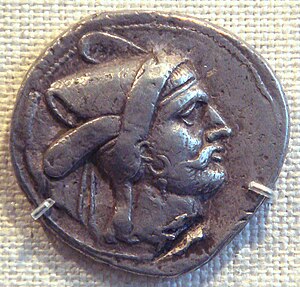
(Minted 290–280 BC) was the first
indigenous Seleucid satrap to be
appointed.
The Seleucid empire’s geographic span, from the
Aegean Sea
to what
is now
Afghanistan
and
Pakistan
, created a
melting pot of various peoples, such as
Greeks
,
Armenians
,
Persians
,
Medes
,
Assyrians
, and
Jews
. The immense
size of the empire, followed by its encompassing
nature, made the Seleucid rulers have a governing
interest in implementing a policy of racial unity
initiated by Alexander.
The
Hellenization
of
the Seleucid empire was achieved by the
establishment of Greek cities throughout the empire.
Historically significant towns and cities, such as
Antioch
, were
created or renamed with more appropriate
Greek
names. The
creation of new
Greek
cities and
towns was aided by the fact that the Greek mainland
was overpopulated and therefore made the vast
Seleucid empire ripe for colonization. Colonization
was used to further Greek interest while
facilitating the assimilation of many native groups.
Socially, this led to the adoption of Greek
practices and customs by the educated native classes
in order to further themselves in public life and
the ruling
Macedonian
class
gradually adopted some of the local traditions. By
313 BC, Hellenic ideas had begun their almost
250-year expansion into the Near East, Middle East,
and Central Asian cultures. It was the empire’s
governmental framework to rule by establishing
hundreds of cities for trade and occupational
purposes. Many of the existing cities began — or
were compelled by force — to adopt Hellenized
philosophic thought, religious sentiments, and
politics.
Synthesizing Hellenic and indigenous cultural,
religious, and philosophical ideas met with varying
degrees of success — resulting in times of
simultaneous peace and rebellion in various parts of
the empire. Such was the case with the Jewish
population of the Seleucid empire because the Jews
posed a significant problem which eventually led to
war. Contrary to the accepting nature of the
Ptolemaic
empire
towards native religions and customs, the Seleucids
gradually tried to force Hellenization upon the
Jewish people in their territory by outlawing
Judaism. This eventually led to the
revolt of the Jews
under Seleucid control, which would later lead to
the Jews achieving independence.
|
|
|
Frequently Asked Questions How long until my order is shipped?: shipment of your order after the receipt of payment. How will I know when the order was shipped?: date should be used as a basis of estimating an arrival date. After you shipped the order, how long will the mail take? international shipping times cannot be estimated as they vary from country to country. I am not responsible for any USPS delivery delays, especially for an international package. What is a certificate of authenticity and what guarantees do you give that the item is authentic? and a Lifetime Guarantee of Authenticity, issued by a world-renowned numismatic and antique expert that has identified over 10000 ancient coins and has provided them with the same guarantee. You will be quite happy with what you get with the COA; a professional presentation of the coin, with all of the relevant information and a picture of the coin you saw in the listing. Compared to other certification companies, the certificate of authenticity is a $25-50 value. So buy a coin today and own a piece of history, guaranteed. Is there a money back guarantee? I offer a 30 day unconditional money back guarantee. I stand behind my coins and would be willing to exchange your order for either store credit towards other coins, or refund, minus shipping expenses, within 30 days from the receipt of your order. My goal is to have the returning customers for a lifetime, and I am so sure in my coins, their authenticity, numismatic value and beauty, I can offer such a guarantee. Is there a number I can call you with questions about my order?
You can contact me directly via ask seller a question and request my telephone number, or go to my About Me Page to get my contact information only in regards to items purchased on eBay. When should I leave feedback? order, please leave a positive. Please don’t leave any negative feedbacks, as it happens many times that people rush to leave feedback before letting sufficient time for the order to arrive. Also, if you sent an email, make sure to check for my reply in your messages before claiming that you didn’t receive a response. The matter of fact is that any issues can be resolved, as reputation is most important to me. My goal is to provide superior products and quality of service. |





![The Jupiter de Smyrne, discovered in Smyrna in 1680[1]](https://upload.wikimedia.org/wikipedia/commons/thumb/c/c8/Jupiter_Smyrna_Louvre_Ma13.jpg/200px-Jupiter_Smyrna_Louvre_Ma13.jpg)

